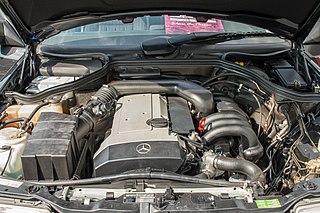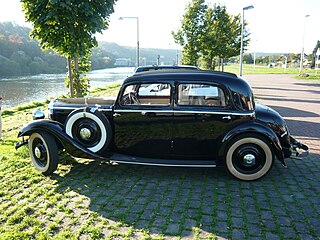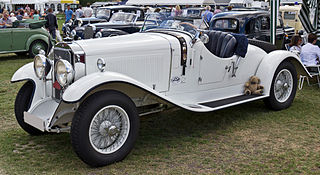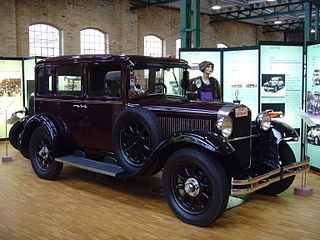Related Research Articles

The Mercedes-Benz M104 is a automobile straight-six engine produced from 1988 through 1999. It has a double overhead cam design with 4 valves per cylinder, and used a crossflow cylinder head. It replaced the M103 and was replaced by the M112 V6 starting in 1997. The bore spacing on all M104 engines is the same as M103 engines.

The Mercedes-Benz Mannheim 350 replaced the W03/Typ 350 models in 1929. The structure originated by Ferdinand Porsche was modified by Hans Nibel.

The Mercedes-Benz W15 is an automobile produced by Mercedes-Benz from 1931 to 1936. Regarded today as a mid-size family car, it was given the chassis designation W15, and sold as the Typ 170 in four-door "Limousine" (sedan/saloon) and Cabriolet forms.

The Mercedes-Benz 380 is an eight-cylinder powered automobile introduced by the German manufacturer Mercedes-Benz at the Berlin Motor Show in February 1933. It was withdrawn from production during 1934. Several models with similar names were produced by Mercedes-Benz during the 1930s, so that in retrospect the car is frequently identified using the manufacturer's Works Number as the W22.

The Mercedes-Benz Typ 230 n was introduced by Mercedes-Benz in 1937 as a successor to the Typ 230 . It was one of several models over the space of nearly eight decades to be sold with a name along the lines "Mercedes-Benz 230", and is therefore in retrospect more normally named according to its internal works designation as the Mercedes-Benz W 143.

The Mercedes-Benz W 21 was a six-cylinder passenger car launched in 1933 using the name Mercedes-Benz Typ 200. It was one of several Mercedes-Benz models known, in its own time, as the Mercedes-Benz 200 and is therefore in retrospect more commonly referred to using its Mercedes-Benz works number, “W21”.

The Mercedes-Benz W 142 was a six-cylinder passenger car launched in February 1937, as a successor to the Mercedes-Benz Typ 290. The car was known by its name Typ 320 at the time of its production and service, but is in retrospect commonly referred to using its Mercedes-Benz works number, "W142", which gives a more unambiguous, unique nomenclature.

The Mercedes-Benz W08 was a large luxury car produced by Daimler-Benz. It was introduced in Autumn 1928, as Mercedes-Benz's first eight-cylinder passenger car. Also known by various “type numbers”, it remained in production with various modifications and upgrades until the later summer of 1939, the longest lived Mercedes-Benz model of the 1920s and 1930s.

The Mercedes-Benz W18 was a six-cylinder automobile introduced as the Mercedes-Benz Typ 290 in 1933. It was a smaller-engined successor to the manufacturer’s Typ 350 / 370 Mannheim model. In terms of the German auto-business of the 1930s it occupied a market position roughly equivalent to that filled by the Mercedes-Benz E-Class in the closing decades of the twentieth century. The W18 was replaced in 1937 by the manufacturer’s W142.

The Mercedes 24/100/140 PS was a large luxury car introduced by Daimler of Untertürkheim in 1924. Production continued until 1929 by which time Daimler had merged with Benz & Cie and the car's name changed to Mercedes-Benz Typ 630. The car was conceptually and structurally similar to the contemporary Mercedes 15/70/100 PS, but the 24/100/140 PS was longer, heavier, more powerful, faster and more expensive.

The Mercedes-Benz W02 was a midsize six-cylinder two-litre-engined automobile introduced by Daimler-Benz at the Berlin Motor Show in October 1926. It was developed in some haste under the manufacturer's Technical Director, Ferdinand Porsche in parallel with the smaller Mercedes-Benz W 01 and the larger three-litre-engined Mercedes-Benz W03 following the creation of Daimler-Benz, formally in July 1926, from the fusion of the Daimler and Benz & Cie auto-businesses.

The Mercedes-Benz W11 was a midsize six-cylinder automobile introduced by Daimler-Benz it 1929. It was developed from the Mercedes-Benz W02 first seen in 1926, and the W11 shared its chassis and bodywork with the W02, but the W11 came with a larger more powerful engine, a new name and a wider list of “standard bodies” from which customers could choose.

The Mercedes-Benz W03 was a large six-cylinder-engined automobile introduced as the Mercedes-Benz 12/55 PS and, initially, as the Mercedes-Benz Typ 300, by Daimler-Benz at the Berlin Motor Show in October 1926. It was developed in some haste under the manufacturer's Technical Director, Ferdinand Porsche in parallel with the smaller Mercedes-Benz W 01 and the two-litre-engined Mercedes-Benz W02 following the creation of Daimler-Benz, formally in July 1926, from the fusion of the Daimler and Benz & Cie auto-businesses.
The Mercedes-Benz M08 engine is a naturally-aspirated and supercharged, 4.6-liter and 5.0-liter, straight-8 engine, designed, developed and produced by Mercedes-Benz; between 1928 and 1940.
The Mercedes-Benz M23 engine is a naturally-aspirated, 1.3-liter, inline-4 gasoline engine, designed, developed and produced by Mercedes-Benz; between 1933 and 1936.
The Mercedes-Benz M18 engine is a naturally-aspirated, 2.9-liter, straight-6, internal combustion piston engine, designed, developed and produced by Mercedes-Benz; between 1933 and 1937.
The Mercedes-Benz M15 engine is a naturally-aspirated, 1.7-liter, straight-6, internal combustion piston engine, designed, developed and produced by Mercedes-Benz; between 1931 and 1936.
The Mercedes-Benz M11 engine is a naturally-aspirated, 2.6-liter, straight-6, internal combustion piston engine, designed, developed and produced by Mercedes-Benz; between 1929 and 1935.
The Mercedes-Benz M04 engine is a naturally-aspirated, 3.0-liter and 3.1-liter, straight-6, internal combustion piston engine, designed, developed and produced by Mercedes-Benz; between 1927 and 1928.
The Mercedes-Benz M02 engine is a naturally-aspirated, 2.0-liter, straight-6, internal combustion piston engine, designed, developed and produced by Mercedes-Benz; between 1926 and 1933.
References
- ↑ Greene, Nik (27 September 2021). Mercedes-Benz Saloon Coupe: The Complete Story. Crowood Press. ISBN 9781785009341 . Retrieved 10 November 2021– via Google Books.
- ↑ "Mercedes-Benz M21 Engine". Sportlichleicht.com. Retrieved 10 November 2021.
- ↑ "MERCEDES BENZ Typ 200 Pullman (W21) specs & photos – 1934, 1935, 1936". Autoevolution.com. Retrieved 10 November 2021.
- ↑ "MERCEDES BENZ Typ 200 (W21) specs & photos – 1933, 1934, 1935, 1936". Autoevolution.com. Retrieved 10 November 2021.
- ↑ "200 (W 21), 1933 – 1936". Mercedes-benz-publicarchive.com. Retrieved 10 November 2021.
- ↑ "Mercedes-Benz E-Class History From 1926 To 2020: The Tale Of The Essential Executive Car". Carscoops.com. 22 August 2020. Retrieved 10 November 2021.
- ↑ "Sports Car Market magazine – August 2008". Keith Martin. Retrieved 10 November 2021– via Google Books.
- ↑ Oswald, pp. 239 & 243
- ↑ Oswald, p. 241